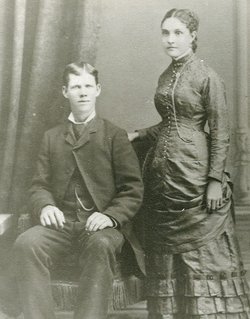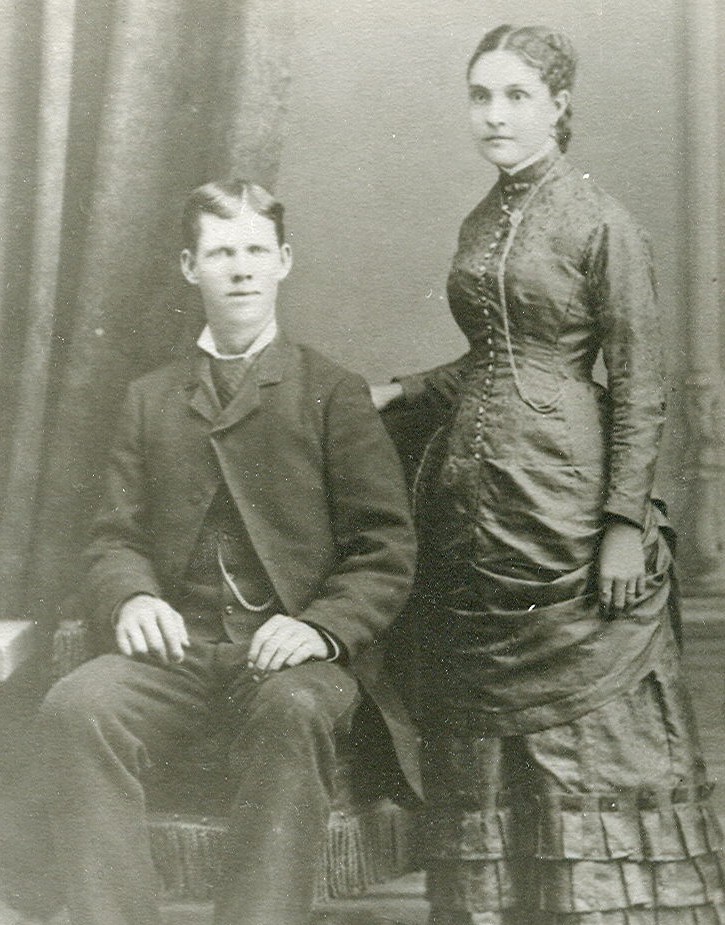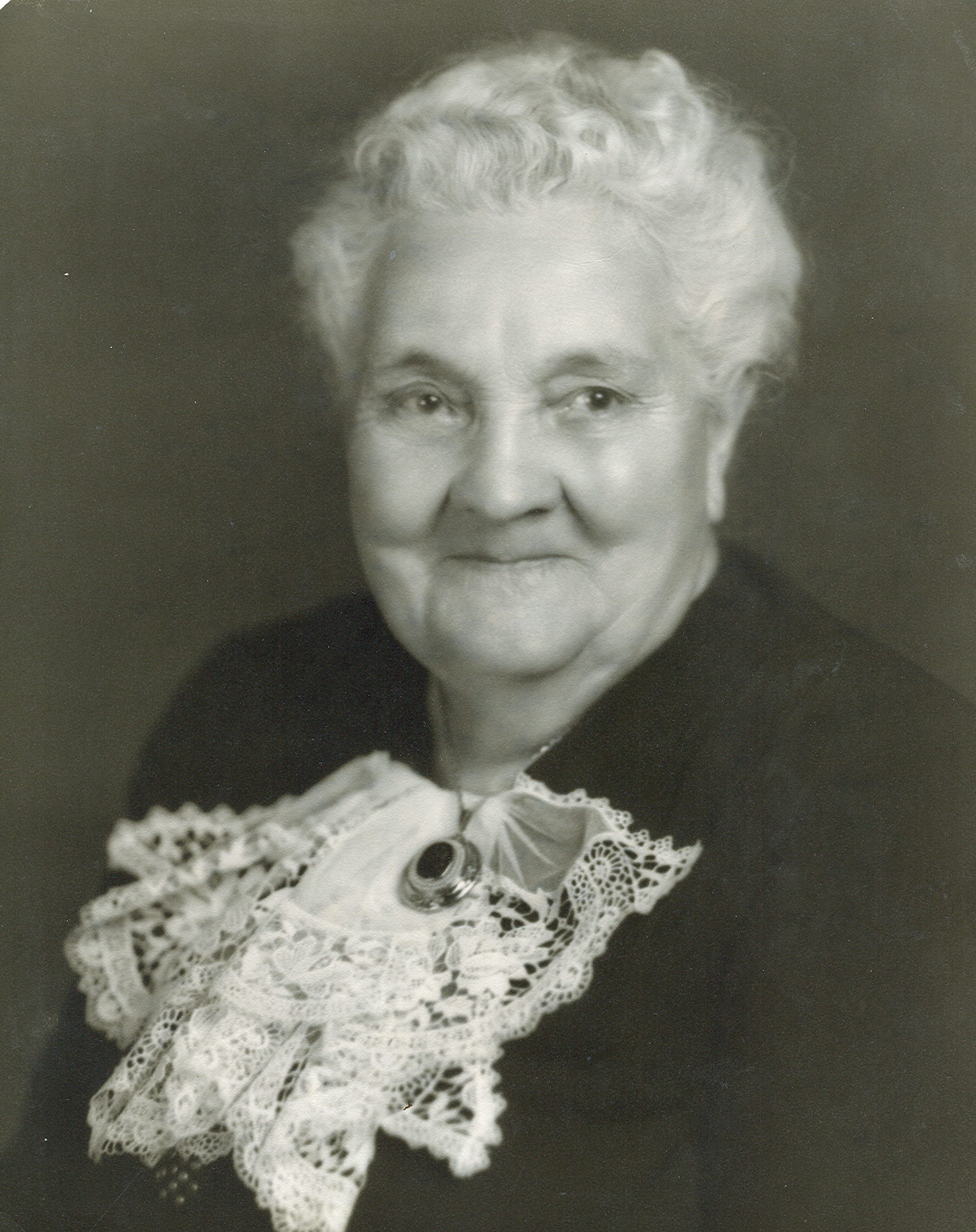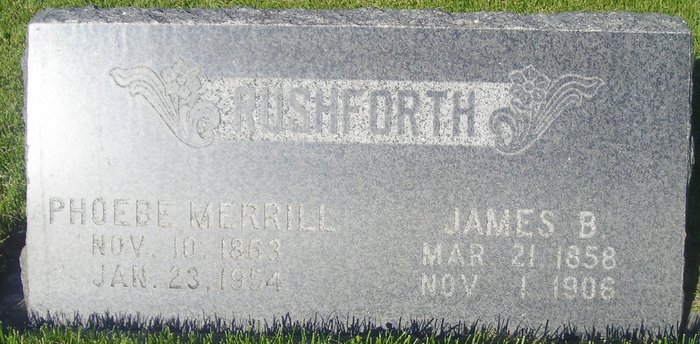Married James Burton Rushforth, 20 Mar 1884, Salt Lake City, Salt Lake, Utah
Children - Mabel Merrill Rushforth, James Rushforth, Parley Lavon Rushforth, Anna Rushforth, Edna Rushforth, Phoebe Merrill Rushforth, Mary Rushforth, Ruby Rushforth, Merrill Rushforth
History of Phoebe Merrill Rushforth:
Phoebe Merrill was born 10 November 1863 in Salt Lake City, Utah. Her mother was Anna Fredricksen, who came to Utah from Norway in 1862. She married a widower Samuel Merrill, whose ancestors came over on the Mayflower. Phoebe was the first born from this union, her mother being 43 years old and her father 82 years old. Two and one-half years later her sister, Rebecca Ruby was born.
These two sisters had half brothers and sisters much older than they were. Among these were two half sisters, Albina, who went with her husband in the Mormon Battalion and Lodema who went as a war nurse at the age of 15 years. Philemon Christopher was a half brother who was body guard to the Prophet Joseph Smith. He also joined the Mormon Battalion. Her father lived to be a hundred years and three days old. Phoebe remembered a band coming and serenading him on his one hundredth birthday.
Phoebe's mother bought an organ with her butter and eggs. Her mother also sold dried fruit at Teasdale Store and bought a nice chair. Phoebe loved good music. As a girl she learned to play the organ and she was a good alto singer and with Ruby her sister, who sang soprano, often sang in the wards in Salt Lake City and in the old Salt Lake Theater. Her activity in the church was in Relief Society and Temple work. Her father was one of the first to have an orchard after leaving Nauvoo, so they dried apples and apricots. They had a raspberry patch and sold raspberries. Strawberries grew wild in the orchard and there was always a good vegetable garden. The Indians used to come to pick up apples. They had a cow which Rebecca (or Ruby as she was called) used to milk but Phoebe never did. Phoebe in later life tried to milk a cow when her husband was away but dried the cow up.
Phoebe was baptized twice because the records were lost. The first time was in the Warm Springs north of the city and the second time in a little pond that ran from mill street across the road where the 22nd ward meeting house now sits.
The school Phoebe attended was held in the 17th ward meeting house. They had to pay $3.00 per term or month to go. Parley P. Pratt's wife used to teach. The school year consisting of two of three months. Phoebe liked to read and crochet, but she usually read aloud while Ruby crocheted.
When Phoebe was ten years old, she and Ruby went to take the cows to the pasture toward the Warm Springs. Coming back a boy came by with a load of lime. The children got on to ride home. Phoebe fell off between the wheels and one wheel passed over her. She didn't tell her mother for fear of worrying her, but in a day or two she was so ill she had to tell her mother. Phoebe felt this injury all her life and was not well for three or four years.
Black Rock was a resort before Lake Point (later called Salt Air) became one and they used to swim summers there, but boat riding was much more popular than swimming as Phoebe and the crowd would boat ride to the island. Refreshments were usually served on the boats.
Phoebe and James were married March 20, 1884 in the old Endowment House in Salt Lake City. They bought a house in Kaysville and moved in as soon as they were married. They drove a flowing well by their home, which had the softest water. It is still used by the present owner. In this home their nine children were born. Their second child, James died with pneumonia. He was christened one Sunday. The next day he seemed to have a cold and was buried the next Sunday. So sorrow came swiftly into this little home.
Phoebe was often left alone. Her closest neighbor a quarter mile through the fields and three miles by the road. Her husband had to go up Weber to the coal beds by team for coal and wood and was away with the thresher during harvesting.
When Phoebe had three children, her friend Lizzie Roundy came back into her life. Lizzie had married Bishop Goodwife from Tremonton in polygamy and like so many others had to go as they used to say "underground" so she came to stay with Phoebe and her husband and stayed hidden there for quite some time. It was at this time also that James Rushforth guarded the lower road from Farmington so if the officers came they could warn President John Taylor who was also in hiding at the Rousche place. Incidentally President Taylor died in exile there.
About 1893, the children were stricken with scarlet fever and Anna, their fourth child never was well again. She lingered for a year. Listless and pale, saying she was alright just so tired. She was a beautiful child and her mother did wish she could find some way of having a picture taken. She passed away at the age of four years old shortly before the sixth child, Phoebe was born.
More hardship came to this pioneer woman. Her husband's health was failing. He could not sleep at night and so she used to read to him in the evenings.
The young folks were always welcome in this humble home and the days and evenings were never dull. Often they gathered here, popped corn, and played games. Sometimes when James felt able, he would play the violin and they would all sing. He often expressed the desire to buy a piano or organ for his family.
In October, 1906, a terrible East wind struck the valley, doing great damage. It blew for nearly twenty-four hours. James Rushforth paced the floor most of the night slipping out between gusts to reinforce the north wall which was swaying out and the roof was lifting. His children were fed, and then put in bed for he feared to make a fire in the home and it was cold.
When the dawn came and the storm ceased the hay was gone and shingles were all off from the house. He was too ill to do all the work and the neighbors were busy repairing their own sheds and gathering their own haystacks up. James began shingling the roof of the home but it was slow work for he lay down on the sloping roof every little while to rest. When it was finished, he came into the house unable to do any more. James kept going until the last, patiently suffering, passing away on November 1, 1906.
So Phoebe was left a widow, her youngest child being three years of age with barely enough money to pay funeral expenses and with cows and horses to feed and little hay. The next few years were years of privation and struggles. The oldest daughter went to work. The farm was rented out on shares and the whole family milked four to five cows and sold milk. During this time a boy who had left home came to live with them. Phoebe felt it would help him from getting into bad company. He stayed nearly six months.
The children went to work as soon as they were able and conditions began to improve. One by one they married until only three were left at home. They were working and teaching a school in Salt Lake City so they sold the home and moved to Salt Lake City where Phoebe had a comfortable home and was close enough to walk to church and the stores.
When the last child married, he moved to Centerville so Phoebe came to Centerville also, moving into a little home just north of the Damberger Station.
During her whole life, Phoebe deeply appreciated the beauties of nature, loved flowers and tried to put the finer things of life into her everyday living. She like to be well dressed with a bright touch of color or jewelry. She was always busy in her later years making beautiful patch work quilts, embroidery work, and crocheting until the last four or five years when her eyesight began to fail. She must have inherited her father's long life for at the age of 81 years she recovered from pneumonia and still lived by herself in her little home until at the age of 89 she could no longer care for herself. She suffered a stroke in August 1953 and passed quietly away at the home of her daughter Edna France on January 23, 1954. She was buried in the Kaysville Cemetery on January 26, 1954.
Married James Burton Rushforth, 20 Mar 1884, Salt Lake City, Salt Lake, Utah
Children - Mabel Merrill Rushforth, James Rushforth, Parley Lavon Rushforth, Anna Rushforth, Edna Rushforth, Phoebe Merrill Rushforth, Mary Rushforth, Ruby Rushforth, Merrill Rushforth
History of Phoebe Merrill Rushforth:
Phoebe Merrill was born 10 November 1863 in Salt Lake City, Utah. Her mother was Anna Fredricksen, who came to Utah from Norway in 1862. She married a widower Samuel Merrill, whose ancestors came over on the Mayflower. Phoebe was the first born from this union, her mother being 43 years old and her father 82 years old. Two and one-half years later her sister, Rebecca Ruby was born.
These two sisters had half brothers and sisters much older than they were. Among these were two half sisters, Albina, who went with her husband in the Mormon Battalion and Lodema who went as a war nurse at the age of 15 years. Philemon Christopher was a half brother who was body guard to the Prophet Joseph Smith. He also joined the Mormon Battalion. Her father lived to be a hundred years and three days old. Phoebe remembered a band coming and serenading him on his one hundredth birthday.
Phoebe's mother bought an organ with her butter and eggs. Her mother also sold dried fruit at Teasdale Store and bought a nice chair. Phoebe loved good music. As a girl she learned to play the organ and she was a good alto singer and with Ruby her sister, who sang soprano, often sang in the wards in Salt Lake City and in the old Salt Lake Theater. Her activity in the church was in Relief Society and Temple work. Her father was one of the first to have an orchard after leaving Nauvoo, so they dried apples and apricots. They had a raspberry patch and sold raspberries. Strawberries grew wild in the orchard and there was always a good vegetable garden. The Indians used to come to pick up apples. They had a cow which Rebecca (or Ruby as she was called) used to milk but Phoebe never did. Phoebe in later life tried to milk a cow when her husband was away but dried the cow up.
Phoebe was baptized twice because the records were lost. The first time was in the Warm Springs north of the city and the second time in a little pond that ran from mill street across the road where the 22nd ward meeting house now sits.
The school Phoebe attended was held in the 17th ward meeting house. They had to pay $3.00 per term or month to go. Parley P. Pratt's wife used to teach. The school year consisting of two of three months. Phoebe liked to read and crochet, but she usually read aloud while Ruby crocheted.
When Phoebe was ten years old, she and Ruby went to take the cows to the pasture toward the Warm Springs. Coming back a boy came by with a load of lime. The children got on to ride home. Phoebe fell off between the wheels and one wheel passed over her. She didn't tell her mother for fear of worrying her, but in a day or two she was so ill she had to tell her mother. Phoebe felt this injury all her life and was not well for three or four years.
Black Rock was a resort before Lake Point (later called Salt Air) became one and they used to swim summers there, but boat riding was much more popular than swimming as Phoebe and the crowd would boat ride to the island. Refreshments were usually served on the boats.
Phoebe and James were married March 20, 1884 in the old Endowment House in Salt Lake City. They bought a house in Kaysville and moved in as soon as they were married. They drove a flowing well by their home, which had the softest water. It is still used by the present owner. In this home their nine children were born. Their second child, James died with pneumonia. He was christened one Sunday. The next day he seemed to have a cold and was buried the next Sunday. So sorrow came swiftly into this little home.
Phoebe was often left alone. Her closest neighbor a quarter mile through the fields and three miles by the road. Her husband had to go up Weber to the coal beds by team for coal and wood and was away with the thresher during harvesting.
When Phoebe had three children, her friend Lizzie Roundy came back into her life. Lizzie had married Bishop Goodwife from Tremonton in polygamy and like so many others had to go as they used to say "underground" so she came to stay with Phoebe and her husband and stayed hidden there for quite some time. It was at this time also that James Rushforth guarded the lower road from Farmington so if the officers came they could warn President John Taylor who was also in hiding at the Rousche place. Incidentally President Taylor died in exile there.
About 1893, the children were stricken with scarlet fever and Anna, their fourth child never was well again. She lingered for a year. Listless and pale, saying she was alright just so tired. She was a beautiful child and her mother did wish she could find some way of having a picture taken. She passed away at the age of four years old shortly before the sixth child, Phoebe was born.
More hardship came to this pioneer woman. Her husband's health was failing. He could not sleep at night and so she used to read to him in the evenings.
The young folks were always welcome in this humble home and the days and evenings were never dull. Often they gathered here, popped corn, and played games. Sometimes when James felt able, he would play the violin and they would all sing. He often expressed the desire to buy a piano or organ for his family.
In October, 1906, a terrible East wind struck the valley, doing great damage. It blew for nearly twenty-four hours. James Rushforth paced the floor most of the night slipping out between gusts to reinforce the north wall which was swaying out and the roof was lifting. His children were fed, and then put in bed for he feared to make a fire in the home and it was cold.
When the dawn came and the storm ceased the hay was gone and shingles were all off from the house. He was too ill to do all the work and the neighbors were busy repairing their own sheds and gathering their own haystacks up. James began shingling the roof of the home but it was slow work for he lay down on the sloping roof every little while to rest. When it was finished, he came into the house unable to do any more. James kept going until the last, patiently suffering, passing away on November 1, 1906.
So Phoebe was left a widow, her youngest child being three years of age with barely enough money to pay funeral expenses and with cows and horses to feed and little hay. The next few years were years of privation and struggles. The oldest daughter went to work. The farm was rented out on shares and the whole family milked four to five cows and sold milk. During this time a boy who had left home came to live with them. Phoebe felt it would help him from getting into bad company. He stayed nearly six months.
The children went to work as soon as they were able and conditions began to improve. One by one they married until only three were left at home. They were working and teaching a school in Salt Lake City so they sold the home and moved to Salt Lake City where Phoebe had a comfortable home and was close enough to walk to church and the stores.
When the last child married, he moved to Centerville so Phoebe came to Centerville also, moving into a little home just north of the Damberger Station.
During her whole life, Phoebe deeply appreciated the beauties of nature, loved flowers and tried to put the finer things of life into her everyday living. She like to be well dressed with a bright touch of color or jewelry. She was always busy in her later years making beautiful patch work quilts, embroidery work, and crocheting until the last four or five years when her eyesight began to fail. She must have inherited her father's long life for at the age of 81 years she recovered from pneumonia and still lived by herself in her little home until at the age of 89 she could no longer care for herself. She suffered a stroke in August 1953 and passed quietly away at the home of her daughter Edna France on January 23, 1954. She was buried in the Kaysville Cemetery on January 26, 1954.
Family Members
-
![]()
Emily Phelps Merrill Dustin
1804–1890
-
![]()
Justin Jared Merrill
1806–1889
-
![]()
Lucy Ann Merrill Gilman
1808–1884
-
![]()
Samuel Bemis Merrill
1812–1891
-
![]()
Pauline Matilda "Polly" Merrill Colton
1817–1891
-
![]()
Lieut Philemon Christopher Merrill Sr
1820–1904
-
![]()
Albina Mariam Merrill Williams
1826–1914
-
![]()
Phoebe Lodema Merrill Thompson
1832–1909
Sponsored by Ancestry
Advertisement
Advertisement

























